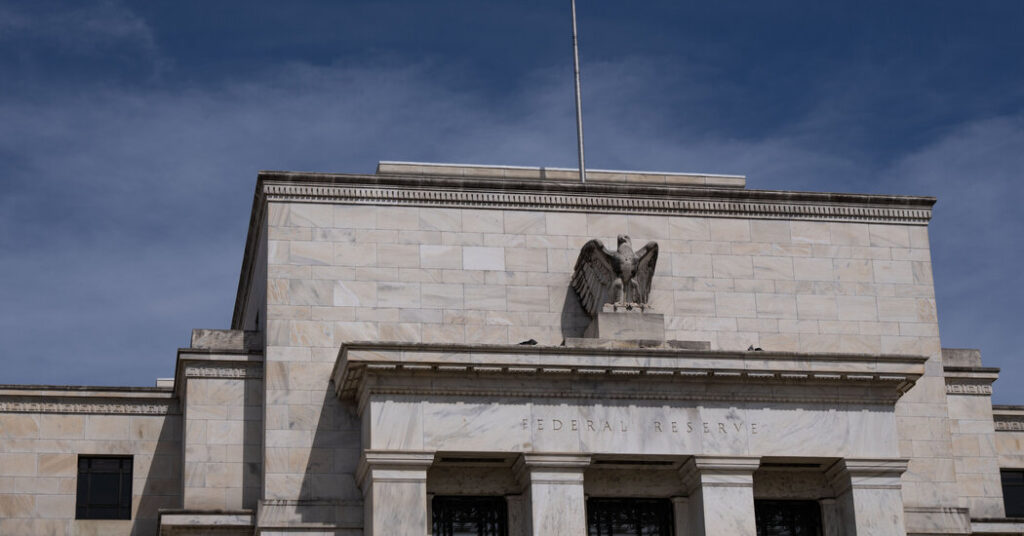Federal Reserve officers welcomed a latest inflation slowdown at their final assembly in late January however had been intent on continuing fastidiously as they tiptoe towards charge cuts, in accordance with minutes from that gathering, which had been launched on Wednesday.
Central bankers raised rates of interest sharply from March 2022 to July 2023, pushing them to five.3 p.c from a place to begin close to zero. Those strikes had been meant to chill shopper and enterprise demand, which officers hoped would overwhelm fast inflation.
Now, inflation is slowing meaningfully. Consumer costs climbed 3.1 p.c within the yr by way of January, down sharply from their latest peak of 9.1 p.c. But that’s nonetheless quicker than the tempo that was regular earlier than the pandemic, and it’s above the central financial institution’s aim: The Fed goals for two p.c inflation over time utilizing a distinct however associated metric, the Personal Consumption Expenditures index.
The financial system has continued to develop at a strong clip whilst value development has moderated. Hiring has remained stronger than anticipated, wage development is chugging alongside and retail gross sales information have instructed that customers are nonetheless prepared to spend.
That mixture leaves Fed officers considering when — and the way a lot — to decrease rates of interest. While central bankers have been clear that they don’t suppose they should increase borrowing prices additional at a time when inflation is moderating, they’ve additionally instructed that they’re in no hurry to chop charges.
“There had been significant progress recently on inflation returning to the committee’s longer-run goal,” Fed officers reiterated of their freshly launched minutes. Officials thought that cooler lease costs, enhancing labor provide and productiveness positive aspects may all assist inflation to average additional this yr. Policymakers additionally instructed that “upside risks to inflation” had “diminished” — suggesting that they’re turning into extra assured that inflation is coming down sustainably.
But additionally they recognized dangers that would pull inflation larger. In specific, “participants noted that momentum in aggregate demand may be stronger than currently assessed, especially in light of surprisingly resilient consumer spending last year.”
When policymakers final launched financial projections in December, their forecasts instructed that they may make three quarter-point charge cuts this yr, to about 4.6 p.c. Investors are actually betting that charges will end 2024 at round 4.4 p.c, although there may be some feeling that they may find yourself barely larger or decrease.
As they give thought to the way forward for coverage, Fed policymakers should stability competing dangers.
Leaving rates of interest too excessive for too lengthy would threat slowing development greater than officers need — a priority that “a couple” of officers raised on the Fed’s late January assembly. Overly tight coverage may push unemployment larger and will even spur a recession.
On the opposite hand, reducing charges prematurely may recommend to markets and on a regular basis Americans that the Fed just isn’t critical about crushing inflation till it’s totally again to regular. If value will increase had been to choose up once more, they might be even more durable to crush down the street.
“Most participants noted the risks of moving too quickly to ease the stance of policy,” the minutes mentioned.
Policymakers are additionally considering when to cease shrinking their stability sheet of bond holdings so quickly.
Officials purchased numerous Treasury and mortgage-backed debt in the course of the pandemic, first to appease troubled markets and later to stimulate the financial system by making even longer-term borrowing cheaper. That swelled the scale of the Fed stability sheet. To scale back these holdings to a extra regular stage, officers have been permitting securities to mature with out reinvesting the proceeds.
But central bankers wish to transfer fastidiously: If they modify the stability sheet too shortly or an excessive amount of, they threat upsetting the plumbing of monetary markets. In reality, that occurred in 2019 after an analogous course of.
Policymakers determined at their assembly that “it would be appropriate” to start in-depth discussions of the stability sheet on the Fed’s subsequent assembly, which is able to happen in March — with some suggesting that it could be helpful to gradual the tempo of the shrinking and that doing so “could allow the committee to continue balance sheet runoff for longer.”


